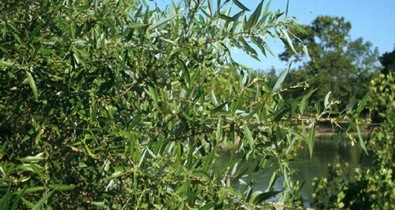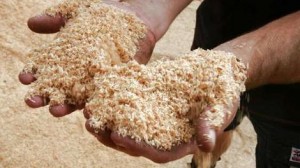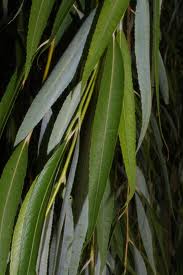
Willow, medicine and famine food
Salix caroliniana: Nothing Would Be Finer
The willow is not prime eats. It’s not even secondary eats. In fact, it is famine food, but, willow can also cure your headache and other pains, so it’s worth knowing about.
The inner bark of the willow is edible, though you probably will have to boil it a few times to make it so. In Scandinavia it was dried, pulverized and mixed with flour to make bread. Don’t be surprised, even sawdust has been added to flour to make bread. In 1918 William Edward Fitch, M.D., wrote in his book “Dietotherapy” that:
“In Sweden and Norway sawdust is sometimes converted into bread, for which purpose beech or some wood that does not contain turpentine is repeatedly macerated and boiled in water to remove soluble matters and then reduce to powder, heated several times in an oven and ground. In this state it is said to have the smell and taste of corn flour…. During the present European war it is claimed that Germany has reported to the use of sawdust in bread making. A friend of the author, traveling in Germany and Switzerland in 1916, was presented with a loaf of this bread which was being used as food for the English and French prisoners.”
Young willow shoots, buds and leaves are also edible but very bitter (and high in Vitamin C.) Boiling is the method commonly used to make them more palatable but they can be eaten raw if you can eat them. In fact, during a trial in Colorado in 1886 a prospector, Alfred Griner Packer, testified his party got lost in the winter of 1874. They went without much food for nine days and then ate first their moccasins. After that they ate willow buds. Lastly, they ate each other though Parker changed his story three times. The jury thought it murder not survival or self-defense and sentenced Packer to 40 years. He was pardoned after some 17 years, worked as a security guard for six years then died in 1907.
So, they ate their shoes before willow buds, then came each other. That doesn’t put willow too high on the food chain. What about curing headaches?
Hippocrates, who was around when the Acropolis was being built, knew that chewing leaves of willow reduced pain for childbirth, and in fact he prescribed it. In North America at least a dozen Indian tribes used willows to relieve fevers, aches, and pains. The willow’s “salicin” was the inspiration to make aspirin. For 60 years in the 1800s scientists tried to make an artificial aspirin that did not upset the stomach greatly. They succeeded in 1893.
You see, when a person eats a willow leaf or some of the bitter inner bark the stomach provides the acid to make it salicylic acid, the pain reliever. But artificial salicylic acid is really tough on the stomach. Eventually they found acetylsalicylic acid, and that is basically the aspirin of today. Back then the Bayer company was a dye maker. One of its chemists, Felix Hoffmann, figured out how to mass produce aspirin. The chemical eases pain by depressing parts of the central nervous system. Aspirin is a made up name. It comes from the ‘A” in acetyl chloride, “spir” from Spiraea ulmaria (the plant they derived the salicylic acid from, Meadowsweet) and ‘in’ which was a familiar name ending for medicines then.
Willow bark can be a source of tannin, black dye, and cordage. The white willow yields cinnamon-colored dye. In most areas where the willow grow locals also used it to make baskets, cages, fishing gear and even horse bridles. Different willows offer different parts for consumption from oozing sweet sap to root tips, Check out your local willow. The weeping willow, a standard ornamental, is also useable. Incidentally, the growing tips soak in a little water make a natural rooting/growth hormone for plants.
The common willow here is Salix caroliniana (SAY-licks kair-oh-lin-ee-AY-nuh.) Salix is the ancient name for willow, possibly from either Gaelic “suil” or “seileach” tree or or willow tree, or from another part of the world Akkadian “salihu” sprinkler of water. Caroliniana means of the Carolinas, read North America.
“Willow Weep for Me” is a popular song composed in 1932 by Ann Ronell. It’s now a jazz standard though Frank Sinatra did a ballard rendition. Ronell was romantically involved with George Gershwin at the time and there is an amazing striking similarity in the song to Gershwin’s bluesy style. Some think Gershwin wrote the song for her and gave her the rights. That is entirely possible in that the song is unmistakenly Gershwinesque. However, in her defense Ronell studied with the famed Walter Piston, the leading composition teacher of the day. His books on composition were standard instruction for generations of music students. She wrote film scores among many things and was more than capable of imitating Gershwin. It just might be the song was her gift to him. More than a generation later Peter and Gordon, and, Chad and Jeremy both recorded their own version of the song as did the aforementioned Sinatra and Etta James, whose recording is far different than Frankie’s.
Green Deane’s “Itemized” Plant Profile
IDENTIFICATION: Leaves alternate, simple, lanceolate 5 to 8 inches long and 3/8 to 1 inch wide. The margins are finely toothed. Upper surfaces smooth,dark green, lower surfaces whitish; stems strong, long, limber. Flowers are catkins emerging at the same time as the new leaves; silk-tipped seeds released from small pods that split in the spring. The Carolina Willow has yellow glands on the tips of the teeth on the leaves — you will need a magnifying glass. It also has at the base of young leaves leaves that resemble mouse ears.
TIME OF YEAR: In southern climes, year round, northern climes spring to fall.
ENVIRONMENT: Likes it feet wet in fresh water
METHOD OF PREPARATION: Shoots, buds, young leaves boiled. Expect them to remain bitter. Inner bark edible as a famine food. Different willows, however, produce different edible parts and more than listed here. Investigate your local willow. Native Americans chewed or boiled tea from the leaves and inner bark to relieve fever, toothache pain, arthritis, and headache.






I have used Carolina or Coastal Plain Willow inner bark for cordage and find it lacking. It may be okay for light purposes but I have found it poor for strength. If after cording I can break it with my own arm strength, it won’t take tension very well. Great for all mentioned uses above including also friction fire and woven baskets (young green shoots and it has little or no shrinkage when dry).
So, what do you find best for cordage?
If using willow tips as a growth hormone, how do you use it? Do you soak the tips in water, then water a plant, or do the tips and a plant/cutting have to soak together?
Yes, cut about four or five inches worth of branch tips, strip off the leaves, and put the tips in water, soak, then use the water to water plants that need hormone treatment.
Are their any weeping willow trees in Maine that you can eat? I’ve also been curious about pine trees and making oak leaf tea. The problem is, I have no idea if have this stuff is poisonous.
One does not eat willow (though the bark is a famine food.) The tips are used as a medicine. Pine needle tea is fine. I think oak-leaf tea is overrated and can be harsh on the system.
I love the beauty of the Weeping Willow tree. I read up on how to grow my own, my roots are in the process of growing.
When my tree is of a decent size; can I use the Aspirin in my Weeping Willow via Leaves instead of damaging its gorgeous bark?
I know this post is old, but replying ASAP is very important.
Thanks!
Isn’t that ‘horse bridles’, unless you are marrying the horse, that is! 🙂
My 10 year old son informed me today that he has been chewing the leaves of a plant in his school garden – around 10 leaves a day. He said the leaves are from a bamboo but I think they are willow – they are the leaves of a young planted arched structure which the children play in.
He is attributing his apparent recent rise in energy to the chewing of the leaves – he is a budding young scientist. But I suspect that his vitality is more to do with the rare sunshine we are currently enjoying here in Sheffield, South Yorkshire England together with the prospect of the approaching summer holidays.
For now I have asked him not to chew the leaves, or indeed any other unidentified leaves, whilst I establish exactly what this plant is. Stick to the dandelion leaves I suggested! I am hoping (!) that his school would not plant anything poisonous or dangerous.
If this plant is, as I believe, a young willow, I am wondering whether it is advisable for children to chew them. Given the interesting link with aspirin type properties, it seems sensible to consider this given that aspirin should not be taken by children under 14 years old.
I’d be most interested to hear your views on this. I suspect the local quack will be bamboozled by willow as well as bamboo!
With many thanks from here in sunny Sheffield.
I have no expertise in medicine or herbalism. But as the willow chemical IS a natural aspirin I think it would be wise to limit its use by children.
I hope this will be some comfort to you! As a child , I would bury myself in gardening books and nature books in general. I tested out my identification skills by nibbling the plant in question. I am afraid I used this method to identify the elderberry bushes we had in our yard ( My parents did not share my interest and never helped me. I read enough to know to leave the abundant nightshade alone. ( Queens NY) When I , along with most of the neighborhood kids , came home from eating the mulberries from a neighbors mulberry tree that we passed on the way to school, my mom predicted I would get terrible diseases since “insects go to the bathroom on plants”. Well, I am now a very healthy 60 year old and still nibble on plants ( now I positively identify them first . So kids do this. Your boy will probably listen to you no more than I listened to my mother ( although parent- child relationships seem closer now , so maybe he will)
Probably he will be just fine. Poisonous stuff doesn’t taste like salad.
Would the mature leaves also be considered edible?
I think not. The Willow is very bitter.
hi
Im wandering if weeping willows leaves are high in vitamin C and can they be grounded and digested as a capsule. the bark as well. Can a person boil the weeping willow and drink a cup a day for medicinal purposes?
KIND REGARDS
Hi, I’m wondering if there would be any problem with making a willow tincture, using the young shoots with 100 proof vodka? I have some golden weeping willow. thanks!